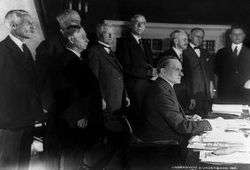Revenue Act of 1926
The United States Revenue Act of 1926, 44 Stat. 9, reduced inheritance and personal income taxes, cancelled many excise imposts, eliminated the gift tax and ended public access to federal income tax returns.

President Coolidge signs the act in a small ceremony.
Passed by the 69th Congress, it was signed into law by President Calvin Coolidge.
The act was applicable to incomes for 1925 and thereafter.[1]
Tax on Corporations
A rate of 13.5 percent was levied on the net income of corporations.
Tax on individuals
A normal tax and a surtax were levied against the net income of individuals as shown in the following table.
| Revenue Act of 1926 Normal Tax and Surtax on Individuals | |||
| Net Income (dollars) |
Normal Rate (percent) |
Surtax Rate (percent) |
Combined Rate (percent) |
| 0 | 1.5 | 0 | 1.5 |
| 4,000 | 3 | 0 | 3 |
| 8,000 | 5 | 0 | 5 |
| 10,000 | 5 | 1 | 6 |
| 14,000 | 5 | 2 | 7 |
| 16,000 | 5 | 3 | 8 |
| 18,000 | 5 | 4 | 9 |
| 20,000 | 5 | 5 | 10 |
| 22,000 | 5 | 6 | 11 |
| 24,000 | 5 | 7 | 12 |
| 28,000 | 5 | 8 | 13 |
| 32,000 | 5 | 9 | 14 |
| 36,000 | 5 | 10 | 15 |
| 40,000 | 5 | 11 | 16 |
| 44,000 | 5 | 12 | 17 |
| 48,000 | 5 | 13 | 18 |
| 52,000 | 5 | 14 | 19 |
| 56,000 | 5 | 15 | 20 |
| 60,000 | 5 | 16 | 21 |
| 64,000 | 5 | 17 | 22 |
| 70,000 | 5 | 18 | 23 |
| 80,000 | 5 | 19 | 24 |
| 100,000 | 5 | 20 | 25 |
- Exemption of $1,500 for single filers and $3,500 for married couples and heads of family. A $400 exemption for each dependent under 18.
gollark: If only I had two accounts so I could be pjals2 and pjals3.
gollark: Time to rename myself pjals2!
gollark: He's impersonating me.
gollark: gollark2 is actually pjals.
gollark: Who thought it was a good idea to have a fixed amount of NBT data per chunk or whatever, and to make it break and corrupt stuff horribly in case of problems?
This article is issued from Wikipedia. The text is licensed under Creative Commons - Attribution - Sharealike. Additional terms may apply for the media files.